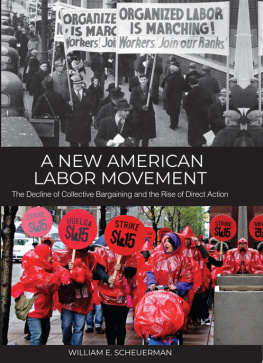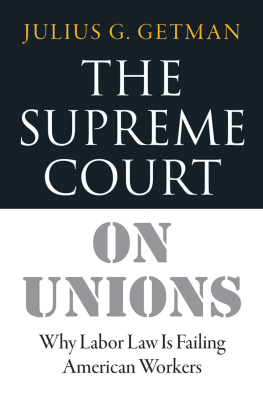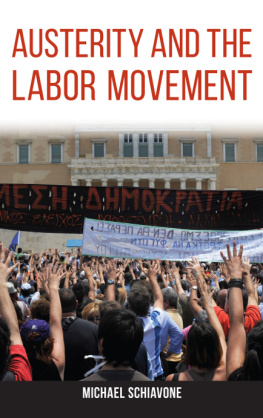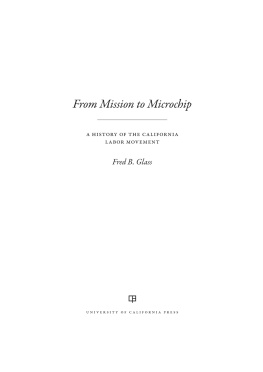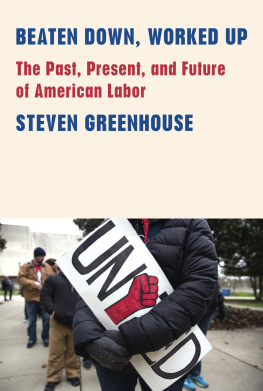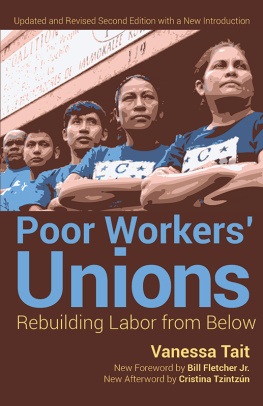A NEW AMERICAN
LABOR MOVEMENT
A NEW AMERICAN
LABOR MOVEMENT
The Decline of Collective Bargaining
and the Rise of Direct Action
WILLIAM E. SCHEUERMAN
Cover images: Photographer unknown. (11437) End of Strike, Cadillac Motor Company, Detroit, Michigan, 1937. January 17, 1937. Walter P. Reuther Library, Wayne State University, Detroit MI. http://reuther.wayne.edu/node/5639
Bob Simpson (BobboSphere), Fight for $15 in Chicago: May 15, 2014,
Licensed with CC BY-SA 2.0. To view a copy of this license, visit
https://creativecommons.org/licenses/by-sa/2.0/
Published by State University of New York Press, Albany
2021 State University of New York
All rights reserved
Printed in the United States of America
No part of this book may be used or reproduced in any manner without written permission. No part of this book may be stored in a retrieval system or transmitted in any form or by any means including electronic, electrostatic, magnetic tape, mechanical, photocopying, recording, or otherwise without the prior permission in writing of the publisher.
For information, contact State University of New York Press, Albany, NY
www.sunypress.edu
Library of Congress Cataloging-in-Publication Data
Name: Scheuerman, William E., 1943 author.
Title: A new American labor movement : the decline of collective bargaining and the rise of direct action / William E. Scheuerman.
Description: Albany, NY : State University of New York Press, 2021. | Includes bibliographical references and index.
Identifiers: LCCN 2021024223 | ISBN 9781438485492 (hardcover : alk. paper) | ISBN 9781438485508 (ebook)
Subjects: LCSH: Labor movementUnited StatesHistory21 century. | Direct actionUnited StatesHistory21st century.
Classification: LCC HD6510 .S34 2021 | DDC 331.88/0973dc23
LC record available at https://lccn.loc.gov/2021024223
10 9 8 7 6 5 4 3 2 1
To my grandchildren
Lizzy, Zoe, Lily, Erik, Charlotte, and Genevieve
the youth of today who will help
create a better tomorrow for all of usArise ye workers from your slumber,
Arise ye prisoners of want.
(The Internationale)
Contents
Acknowledgments
The determination and commitment of those battling for social and economic justice inspired me to write this modest book. I thank them for the many sacrifices they make and the hope they give us for a better future. My great appreciation also goes to those participants in the struggle who found the time to talk to me and tolerate my often nave questions. Edward Escobar of the Alliance for Independent Workers was a fantastic source of information. His patience and willingness to assist went well beyond anything I could have expected. As one who has felt the sting of abusive corporate power, Edward helped me understand why some California gig drivers want to become real independent contractors rather than corporate employees. Freelance worker Halley Bondy put the concerns of freelance workers in perspective, as did the recently appointed head of the Freelancers Union, Rafael Espinal. And many thanks to Bob Simpson for allowing me to use his photo of a Fight for $15 rally on the book cover. Two good friends and former colleagues in the New York State United Teachers union, Alan Lubin and Brian OShaughnessy, invited me to meetings of the Rural & Migrant Ministry and spent hours with me analyzing issues facing farmworkers. Many of my academic friends and former colleagues contributed to this work as well. Mike Urban reviewed several chapters and made a number of insightful comments. Sid Plotkin, Ray Petersen, Ray Borycka, Vinnie Seravallo, and Artie Siegel, my childhood friend from the old neighborhood, also read the manuscript during its various stages of development. My son and namesake, Bill, read parts of the manuscript and was not shy in pointing out some shortcomings he found in an early draft of the conclusion. I thank him for his intellectual rigor and honesty. My wife Louise deserves thanks for reading the various drafts of the book and living through months of my self-imposed exile to libraries or meetings or to my study. Finally, I owe my greatest thanks to all my sisters and brothers in the labor movement who have dedicated their lives, often at great personal cost, in the seemingly endless struggle against the forces of economic and political oppression. Needless to say, the books shortcomings are the sole responsibility of the author.
Introduction
On a crisp October day in downtown Albany, New York, a small coalition of fast-food, retail, and transportation workers and their supporters took to the streets. The sound of a voice through a bullhorn pierced the air. What do we want? the voice roared.
Paid sick leave! the crowd answered.
When do we want it?
Now!
This Central Avenue rally wasnt their first. Previously, coalition members conducted silent protests before the Albany County Legislature to secure a law requiring all area employers to allow both part-time and full-time workers to earn paid sick leave. Strategically, the coalition linked its demands to the larger communal good of protecting public health. All the protesters wore surgical masks. I Served Food With the Flu, read one protesters sign. Their actions worked. The county legislature drafted such a bill.
Theres a new spontaneous energy in the labor movement, and a new kind of direct action is its engine of change, born of the decades-long war against unions that has blocked vast numbers of American workers from the bargaining table. These direct action movements are taking place mainly outside the realm of organized labor and are in the process of reshaping the American labor movement. Conscious of their economic vulnerability and no longer willing to accept the economic and social status quo, tens of thousands of exploited workers in industries running the gamut from farm laborers and gig drivers to freelance artists and fast-food employees have taken to the streets in a collective attempt to attain a living wage and decent working conditions. This spontaneous new militancy, an upsurge of vibrant democracy from below, expressed through mass demonstrations, strikes, sit-ins, political action, and similar activities, has already achieved some successes and offers models for workers to exercise their power in the twenty-first century.
The history of the union movement in the United States has been the subject of an endless number of studies. And recent decades have produced countless analyses of why unions are in decline. Along the way, this book will briefly recap that history and summarize various factors cited as contributing to the union movements current sorry state. This work argues that all these analyses are partially correct, but they fail to address the core of the problem: the structure and culture of organized labor no longer serve the larger labor movement.
This book frames the rise and development of the new labor movement in light of organized labors decline by asking a number of important questions. The first series of questions arises from the historical contributions of labor unions, their current condition, and their future prospects: Why are unions important, and why does it matter that theyre on the decline? Why are they losing members? What, if anything, can they do to reverse this decline? Finally, what are the social and political implications of a weak and ineffectual union movement? A second group of questions examines the new labor movement that has emerged outside the parameters of organized labor: What economic and social changes have given birth to this new militant labor movement? What are the goals of these new organizing groups, and what are they doing to realize them? What is their relationship to unions and to electoral politics? How might this relationship evolve? A third, and not inconsequential, set of questions looks at the impact of the Covid-19 pandemic on these workers and their direct action movements.

